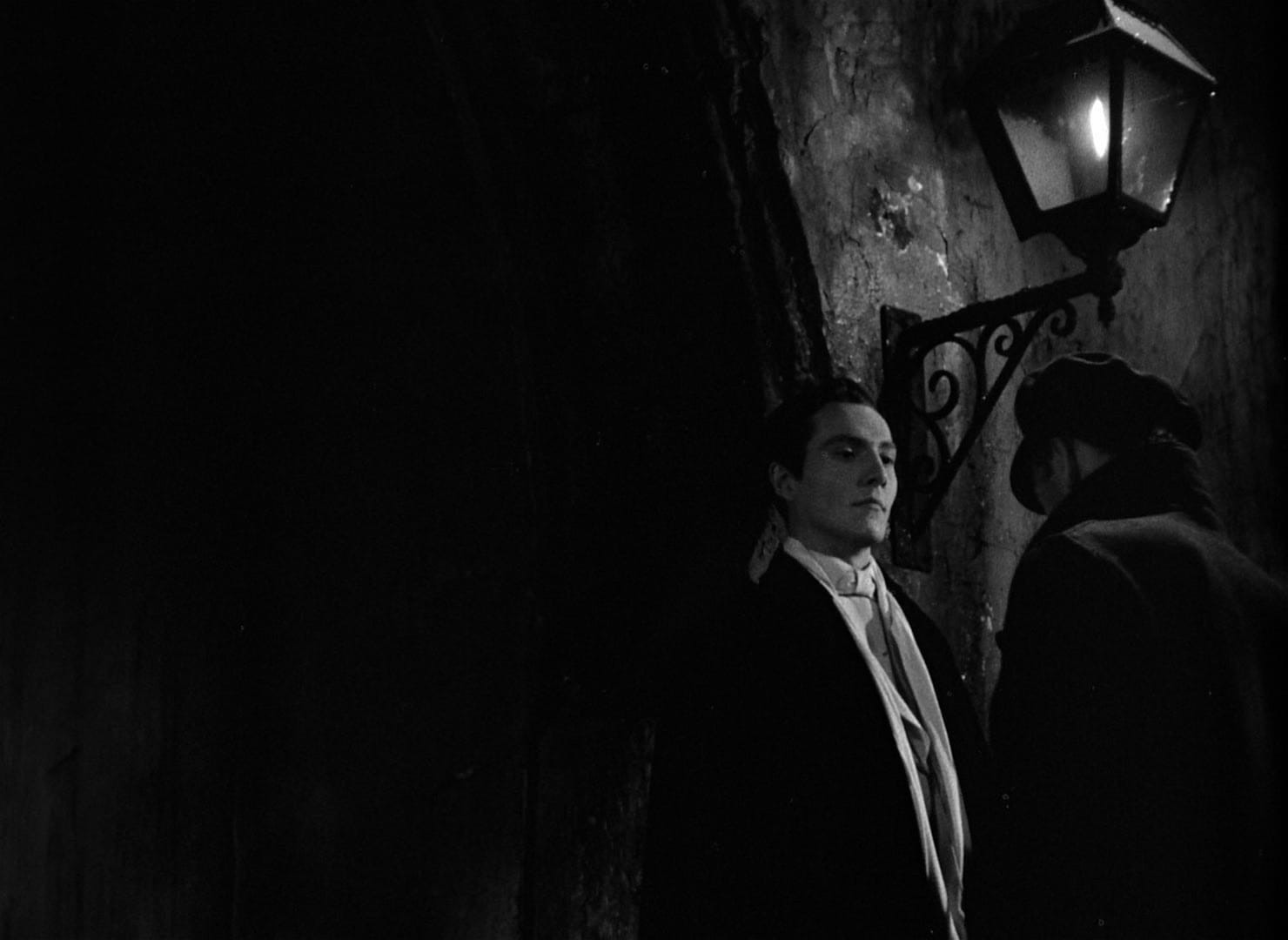RELATED ARTICLE
Turn the Gaze Around
The Ache of Desire
The Criterion Collection

Standing before his friend Basil Hallward’s portrait of him, the paint barely dry, Dorian Gray implores to some unseen force: “If it were I who was to be always young, and the picture that was to grow old . . . For that—for that—I would give everything! Yes, there is nothing in the whole world I would not give! I would give my soul for that!”
These precise words appear in both Oscar Wilde’s 1890 novel The Picture of Dorian Gray and—minus that wonderful extra for that—the 1945 film version, directed by Albert Lewin. In both, they clinch the character’s Faustian bargain. The novel doesn’t provide any literal rationale for why Dorian’s wish comes true—the inherently amoral, unnatural request seems to create its own kind of magical possibility, a tear in the rational universe that cannot be mended. Lewin’s film gives us a symbolic framework, however, a supernatural medium that might help “explain” the horror to follow: a statue of a cat that Basil keeps in his studio and that Dorian’s acerbic shoulder-devil Lord Henry Wotton calls “one of the seventy-three great gods of Egypt,” capable of granting wishes. This Orientalist conceit lends the film a touch of the exotic-sinister, firmly placing Lewin’s The Picture of Dorian Gray into a more clearly delineated tradition of Hollywood horror, following Edgar Ulmer’s The Black Cat (1934) and Jacques Tourneur and Val Lewton’s Cat People (1942), two of the most sensual and perverse of all American creep-shows. The statue of the black cat doesn’t factor much into the rest of Lewin’s film, but it does recur often in the frame, inexplicably relocated to Dorian’s own parlor. Like Dorian, it will never change; like him, it’s elegant and cold, a sleek slab of stone.
Wilde held homosexual love and attraction to an almost mythic ideal, symbolic of a Hellenistic utopia, a daring principle at a time when one could be imprisoned for acting upon same-sex attraction. For the famous—in some circles, notorious—author, Dorian’s ruthless pursuit of youth functioned as an extreme fun-house reflection of the writer’s own former beliefs in the necessity of separating aesthetics from morality, a tenet of his “art for art’s sake” philosophy. In Lewin’s mesmeric MGM adaptation, Dorian remains an avatar for a late-Victorian world rotting in decadent superficiality, but his beauty is replaced by something harder, steelier, and altogether more unnerving.
Wilde describes Dorian as though he were Narcissus, “wonderfully handsome, with his finely curved scarlet lips, his frank blue eyes, his crisp gold hair.” Lewin’s version is inhabited by Hurd Hatfield, an actor of ethereality but no grace. There’s nothing curved or luscious about this Dorian’s mouth, and his top lip practically disappears over his teeth when he talks; his eyes appear, at least in the film’s black-and-white cinematography, as vacant dark orbs; and his hair is harshly brunet, combed back severely over a recessive forehead. He’s handsome, though never sensual; the giddy, marvelous Dorian of Wilde’s novel is here instead intelligent yet passive, a kind of gargoyle.

The recalibration of Dorian as a frigid, nonsexual being is essential to the film’s overall aesthetic—there’s a frosty affectlessness to most of the performers, who are often placed within the frame as though figures in a tableau, delivering their lines in a flat moderation that consistently neutralizes any sense of melodrama despite the film’s many tragic, lurid turns. But the lack of overt sensuality in Hatfield’s incarnation indicates a crucial difference between how the film and the book depict Dorian and his decadence—a term long used as code for queerness. Though both Wilde and Lewin had to function within their respective social codes, the earthy, narcissistic beauty of Wilde’s Dorian is replaced by Lewin and Hatfield’s cold, cruel, raven-haired mannequin. In other words, the film represents queerness the way classical Hollywood cinema always did: like that uncanny black cat, it’s an eerie monstrosity.
While The Picture of Dorian Gray was Wilde’s only foray into supernatural terror, homosexuality is the spectral subtext of much English and American horror literature of the nineteenth and early twentieth centuries, in which spirits and demons were manifestations of repressed queer desires—most famously, there’s Mary Shelley’s Frankenstein, with its mad doctor’s physical and spiritual admiration of his powerful Prometheus; Robert Louis Stevenson’s 1886 novella The Strange Case of Dr. Jekyll and Mr. Hyde, which has been analyzed by queer theorists as an evocation of primal urges emerging from polite society’s closet; Henry James’s 1898 novella The Turn of the Screw, in which the ghoulish children Miles and Flora have possibly been twisted and corrupted by exposure to frightening—and fascinating—sexual extremity; and the ghost stories of probable closet case M. R. James, especially 1904’s divinely scary “Oh, Whistle and I’ll Come to You, My Lad,” in which a bachelor at a seaside resort is terrorized by a looming figure in the adjoining bed.